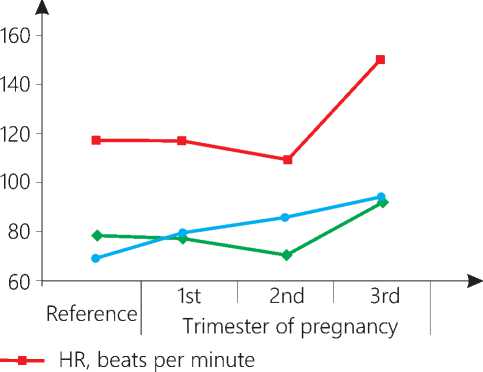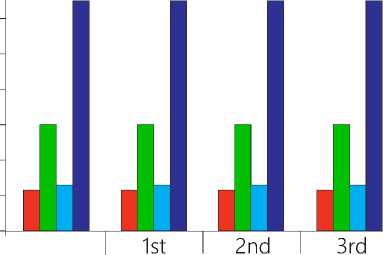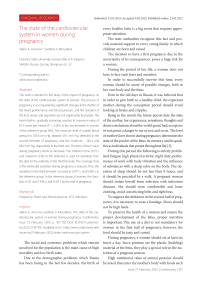The state of the cardiovascular system in women during pregnancy
Автор: Anzorov V.A., Moryakina S.V.
Журнал: Cardiometry @cardiometry
Рубрика: Original research
Статья в выпуске: 21, 2022 года.
Бесплатный доступ
The work is devoted to the study of the impact of pregnancy on the state of the cardiovascular system in women. The process of pregnancy is accompanied by significant changes in the rhythm of the heart performance and blood pressure, and the duration of the ECG waves and segments are not significantly fluctuated. The heart rhythm, gradually increasing, reaches its maximum value of 87.3 beats per minute (P
Pregnancy, heart rate, blood pressure, ecg indicators
Короткий адрес: https://sciup.org/148324172
IDR: 148324172
Текст научной статьи The state of the cardiovascular system in women during pregnancy
Imprint
Vakha A. Anzorov, Svetlana V. Moryakina. The state of the cardiovascular system in women during pregnancy. Cardiometry; Issue 21; February 2022; p. 107-110; DOI: 10.18137/cardiome-try.2022.21.107110; Available from: issues/no21-february-2022/state-cardiovascular-system
The social and economic problems which remain unsolved for the population is the main cause of high mortality and low birth rates.
Due to the demographic problems which Russia has been facing in the last few decades, the birth of every healthy baby is a big event that requires appropriate attention.
The state authorities recognize this fact and provide material support to every young family in which children are born and raised.
The decision to have a first pregnancy, due to the uncertainty of its consequences, poses a huge risk for a woman.
During the period of her life, a woman does not have to face such fears and anxieties.
In order to successfully survive this time, every woman should be aware of possible changes, both in her own body and the fetus.
Even in the old days in Russia, it was believed that in order to give birth to a healthy child, the expectant mother during the conception period should avoid looking at freaks and cripples.
Being in the womb, the future person feels the state of the mother, her experiences, sensations, thoughts and draws conclusions about the world: good; bad; accept me or not; poses a danger to me or not, and so on. The level of mother’s love shown during pregnancy determines the state of the psyche of the fetus, its memory and its qualities as individuals that persist throughout life [3].
During this period, the following is strictly prohibited: fatigue; high physical activity; night duty; performance of work with body vibration and the influence of substances with a sharp odor on the body. The duration of sleep should be not less than 8 hours, and it should be preceded by a walk. A pregnant woman should isolate herself from infection with infectious diseases. She should wear comfortable and loose clothing, avoid constricting belts and tight bras.
To support the abdomen in the second half of pregnancy, it is necessary to wear a bandage. Shoes should not be high heels.
To preserve the health of a woman and ensure the proper development of the fetus, proper nutrition is important. The use of a diet is not mandatory for women in the first half of pregnancy, however, the food should be tasty and varied.
During pregnancy, a woman should eat at least six times a day. Since proteins are the plastic (building) material of the fetus, they play a special role in the nutrition of a pregnant woman.
High nutritional value of animal proteins should be noted that enter the mother’s body with foods such
Issue 21. February 2022 | Cardiometry | 107
as eggs, meat, fish and dairy products. The need of a pregnant woman is also high in products containing plant proteins. These are soy and nut proteins.
In the diet, preference should be given to fruits, berries and vegetables. Fats should be used in the form of butter, sour cream and vegetable oils. During pregnancy, the need for vitamins increases, and therefore foods rich in vitamins should predominate in the diet.
Advances in the development of physiology put forward in the relationship between the mother and the fetus, the need to reassess the data on the functional activity of body systems [11].
This need is due to the fact that the mother and the fetus are two independent organisms, which are united by the satisfaction of the needs of the fetus, which ensure the normal development of the embryo.
Deviations in the embryonic development of the fetus can be caused both by disturbances in the genetic apparatus of the fetus, and by the influence of some environmental factors. This means that the optimal state of environmental conditions alone is not enough to ensure the normal development of the fetus.
Also, for this, it is necessary to maintain the constancy of the internal environment in the mother-fetus system, which ensures the development of the fetus according to the genetic plan.
Identification of changes occurring in the body of a pregnant woman will allow us, through preventive measures, to avoid the development of possible pathologies [14]. A woman’s illness during pregnancy poses a threat not only to the body of the expectant mother, but also to the normal development of the fetus.
Therefore, the determination of indicators of the cardiovascular system, as one of the most important in the body, during pregnancy is important and relevant.
In order to identify changes in the cardiovascular system of women during pregnancy, we conducted research in the maternity department of the Urus-Martan district hospital.
Materials and methods
The object of our research were 50 clinically healthy women, whose age ranged from 23 to 25 years. Among them, two groups were formed, each group consisted of 25 women. Women in the reference group did not have a pregnancy, while the experimental ones were pregnant, and its duration was the same.
The conditions for the inclusion of women in the experimental group were their consent and the absence of contraindications for the course of pregnancy. Blood samples were taken at the end of each trimester of pregnancy, in the morning before taking water and food.
Heart rate and arterial blood pressure values were determined using expert digital automatic tonometer OMRON M3.
Electrocardiogram parameters were recorded using an Alton-03 electrocardiograph.
The “Biostatistics” software was used for statistical processing of the experimental data.
Results and Discussion
The dynamics of the cardiovascular system indicators in women during pregnancy is shown in Table 1 and in Figures 1 and 2 herein.
Table 1
The impact of pregnancy on the cardiovascular system indicators
|
Indicators |
Reference |
Trimester of pregnancy |
||
|
1 |
2 |
3 |
||
|
HR, beats per minute |
69.8±1.24 |
78.6±1.18**** |
81.5±1.26**** |
87.3±1.51**** |
|
Systolic blood pressure, mm Hg |
117.0±2.03 |
116.2±1.67 |
105.6±1.82*** |
146.4±2.18**** |
|
Diastolic blood pressure mm Hg |
78.2±1.41 |
77.7±1.52 |
69.5±1.62*** |
88.0±1.94*** |
|
P, s |
0.076±0.0018 |
0.074±0.0015 |
0.073±0.0016 |
0.070±0.0032 |
|
PQ, s |
0.162±0.0040 |
0.158±0.0043 |
0.156±0.0044 |
0.151±0.0047 |
|
QRS, s |
0.083±0.0014 |
0.081±0.0025 |
0.080±0.0026 |
0.077±0.0029 |
|
QT, s |
0.346±0.0033 |
0.340±0.0044 |
0.337±0.0045 |
0.331±0.0075 |
*** – P < 0,01; **** – P < 0,001
108 | Cardiometry | Issue 21. February 2022

—♦— Systolic blood pressure, mm Hg
• Diastolic blood pressure, mm Hg
Figure 1. Cardiovascular system in women during pregnancy

Список литературы The state of the cardiovascular system in women during pregnancy
- Anzorov VA, Moryakina SV, Abumuslimov SS. Dynamics of indicators in the cardiorespiratory system during pregnancy. Bulletin of the Chechen State University. Grozny: Chechen State University Publishing, 2016; 4(24):28-32. [in Russian]
- Gorohova S.G., et al. Echocardiographic study algorithm in pregnant women. Russian Journal of Cardiology. 2018; 23(12): 75-82. [in Russian]
- Eliseev YY. Pregnancy from A to Z. A complete guide. Moscow: Eksmo, 2018. 576 p. [in Russian]
- Kishkun AA. Guide to laboratory diagnostic methods. Moscow: GEOTAR-Media, 2014. 60 p. ISBN 978-5-9704-3102-3. URL: https://www.rosmedlib.ru/book/ISBN9785970431023.html [in Russian]
- Kertis G, Schuler D. Guide to pregnancy. From impregnation to childbirth. Moscow: Eksmo, 2018. 320 p. [in Russian]
- Potapova MV, Makarova YA, Shamrova EA, Belova OA. Cardiovascular diseases in women during pregnancy, features of pathogenesis and clinical course. Scientific Review. Medical Sciences. 2021; 3: 85-89. [in Russian] URL: https://science-medicine.ru/ru/article/view?id=1196
- Guidelines of the European Society of Cardiology for the treatment of cardiovascular diseases in pregnant women. Rational pharmacotherapy in cardiology. Moscow, 2012; 3: 58 p.
- Savelyeva GM, Sukhikh GT, Serov VN, Radzinsky VE. Obstetrics: a national guide. Moscow: GEOTAR-Media, 2018. 1088 p. [in Russian]
- Simkin P, Valley J, Keppler E. Pregnancy. Practical guide. Series: Popular medicine. Moscow: FAIRPRESS, 2009. 576 p. [in Russian]
- Stone Joanna. Pregnancy is for dummies. Moscow: Dialectics, 2016. 386 p. [in Russian]
- Strebeleva EA. The main etiopathogenetic factors of mental and somatic health disorders in orphans. Orphans: Counseling and developmental diagnostics. 1998. 98 p. [in Russian]
- Stryuk RI, et al. Diagnostics and treatment of cardiovascular diseases during pregnancy. National guidelines. Russian Journal of Cardiology. 2018; 3(155): 91-134. [in Russian]
- Chekashkina EE, et al. Heart rate variability in pregnant women with ventricular extrasystoles. Bulletin of the Mordovian University. 2016; 26-1: 122-133. [in Russian]
- Ashrafi R, Curtis SL. Heart Disease and Pregnancy. Cardiol Ther. 2017; 6(2): 157-73.


